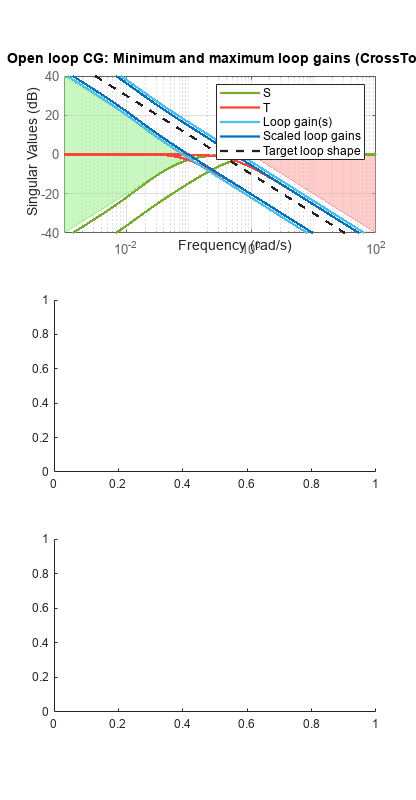loopview
Graphically analyze MIMO feedback loops
Description
loopview(
plots characteristics of the positive-feedback, multi-input,
multi-output (MIMO) feedback loop with plant G,C)G
and controller C.

Use loopview to analyze the performance of a
tuned control system you obtain using looptune.
Note
If you are tuning a Simulink® model with
looptune through an
slTuner interface, analyze
the performance of your control system using
loopview (Simulink Control Design) for
slTuner (requires Simulink
Control Design™).
loopview plots the singular values of:
Open-loop frequency responses
G*CandC*GSensitivity function
S = inv(1-G*C)and complementary sensitivityT = 1-SMaximum (target), actual (tuned), and normalized MIMO stability margins.
loopviewplots the multi-loop disk margin (see Stability Analysis Using Disk Margins (Robust Control Toolbox)). Use this plot to verify that the stability margins of the tuned system do not significantly exceed the target value.
For more information about singular values, see sigma.
loopview(
uses the G,C,info)info structure returned by looptune. This
syntax also plots the target and tuned values of tuning constraints
imposed on the system. Additional plots include:
Singular values of the maximum allowed
SandT. The curve markedS/T Maxshows the maximum allowedSon the low-frequency side of the plot, and the maximum allowedTon the high-frequency side. These curves are the constraints thatlooptuneimposes onSandTto enforce the target crossover rangewc.Target and tuned values of constraints imposed by any tuning goal requirements you used with
looptune.
Use loopview with the info
structure to assist in troubleshooting when tuning fails to meet all
requirements.
Examples
Input Arguments
Alternatives
For analyzing Simulink models tuned with looptune through an
slTuner (Simulink Control Design) interface,
use loopview (Simulink Control Design) for
slTuner (requires Simulink
Control Design).
Version History
Introduced in R2011bSee Also
looptune | slTuner (Simulink Control Design) | looptune (for
slTuner) (Simulink Control Design) | loopview (for
slTuner) (Simulink Control Design)
